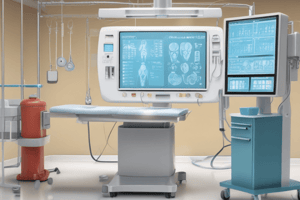Podcast
Questions and Answers
What is the purpose of the secondary assessment?
What is the purpose of the secondary assessment?
The purpose of the secondary assessment is to obtain quantifiable information about the patient's overall health condition, which can be used to create a field diagnosis.
What are the 2 components of the secondary assessment?
What are the 2 components of the secondary assessment?
The two components are obtaining vital signs and conducting a physical head-to-toe exam.
What physical findings do you look for when assessing a patient's respiratory status?
What physical findings do you look for when assessing a patient's respiratory status?
Look for chest symmetry, deformities, the use of accessory muscles, retractions, and abnormal breath sounds.
What physical findings do you look for when assessing a patient's cardiovascular system?
What physical findings do you look for when assessing a patient's cardiovascular system?
What are five aspects of assessing a patient's neurological status?
What are five aspects of assessing a patient's neurological status?
What is DCAP-BTLS and what does it stand for?
What is DCAP-BTLS and what does it stand for?
What important information can be gathered from the assessment of the ears in a trauma patient?
What important information can be gathered from the assessment of the ears in a trauma patient?
Describe how to assess the abdomen and what physical findings may you encounter?
Describe how to assess the abdomen and what physical findings may you encounter?
What are 3 considerations when performing a secondary assessment on children?
What are 3 considerations when performing a secondary assessment on children?
What is the goal of performing a reassessment?
What is the goal of performing a reassessment?
Reassessment consists of repeating the primary assessment by evaluating the airway, breathing, and ______.
Reassessment consists of repeating the primary assessment by evaluating the airway, breathing, and ______.
How often should vital signs be rechecked?
How often should vital signs be rechecked?
Flashcards are hidden until you start studying
Study Notes
Secondary Assessment Overview
- Secondary assessment provides quantifiable information about a patient's health condition to aid in creating a field diagnosis.
- Combines objective data (vital signs) with subjective information shared by the patient.
Components of Secondary Assessment
- Two main components:
- Vital Signs: Blood pressure, respiratory rate, pulse rate, pulse oximetry, skin condition.
- Physical Head-to-Toe Exam: Evaluates specific body system functions.
Respiratory System Assessment
- Expose the chest and check for symmetry and deformities, like flail chest.
- Look for the use of accessory muscles or retractions, indicating respiratory distress.
- Auscultate lungs for abnormal breath sounds.
Cardiovascular System Assessment
- Assess blood pressure and identify any major bleeding.
- Evaluate pulse rhythm, rate, and quality.
- Examine skin condition for signs of perfusion issues.
Neurological Status Assessment
- Use the AVPU scale to gauge the level of consciousness.
- Assess memory through questions regarding person, place, time, and event.
- Evaluate speech rate, quantity, appropriateness, logic, and organization of thought.
- Observe the patient's appearance and behavior, including facial expressions and posture.
DCAP-BTLS Acronym
- Mnemonic for injury assessment:
- D: Deformities
- C: Contusions
- A: Abrasions
- P: Punctures/Penetrations
- B: Burns
- T: Tenderness
- L: Lacerations
- S: Swelling
Ear Assessment in Trauma
- Examine ears for cerebrospinal fluid (CSF) drainage.
- Presence of fluid indicates potential skull fracture and increased risk of bacterial meningitis.
Abdominal Assessment
- Expose abdomen and check for DCAP-BTLS.
- Palpate all four quadrants for masses indicating bowel obstruction or tumors.
- Tenderness may suggest internal bleeding.
Considerations for Assessing Children
- Limited information due to shyness or inability to communicate; rely on physical findings and vital signs.
- For young children, conduct exams from toe-to-head to build trust and reduce fear.
- Always assess for trauma; children are highly susceptible to dehydration and infection.
Reassessment Goals
- Monitor overall patient condition and effectiveness of interventions.
- Identify trends in vital signs.
Reassessment Procedure
- Repeat primary assessment focusing on airway, breathing, and circulation.
- Address the chief complaint and recheck vital signs; assess small wounds.
- Perform reassessment whenever a patient's condition changes.
Frequency of Vital Sign Monitoring
- Stable patients: recheck vital signs every 15 minutes.
- Unstable or critically ill patients: recheck every 5 minutes due to higher deterioration risk.
Studying That Suits You
Use AI to generate personalized quizzes and flashcards to suit your learning preferences.




